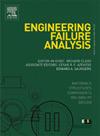Experimental and CFD investigation of fatigue damage of welded cantilever under high-speed train
IF 4.4
2区 工程技术
Q1 ENGINEERING, MECHANICAL
引用次数: 0
Abstract
This paper deals with the fatigue damage of the welded cantilever under a high-speed train subjected to wind-induced loading using a field test campaign and a CFD (Computational Fluid Dynamic) simulation. The results show that significant airflow pressure on the cantilever frames and the structural resonance are the main cause of the fatigue damage of welded joints. During long-term operation, the free end of the cantilever tends to vibrate undesirably, which affects the service life of the structure. Firstly, a finite element model with constant amplitude of wind pressure is created based on the current design specifications to assess the static and fatigue strength of the cantilever. The simulation results show that the structural strength meets the standard design requirements. However, the results of the field test show that the acceleration at the free end of the cantilever is 32.0 m/s2, which far exceeds the relevant requirements. Meanwhile, there is a significant difference in aerodynamic pressure on the frame surfaces between the leading and trailing cars. An aerodynamic model is created for two full-size cars with the CFD method. The results show that FIV (flow-induced vibration) is the main cause of the continuous vibration of the elastic cantilever frame as long as the wake shedding occurs at a frequency close to the natural frequency of the frame. This study provides a reference for the aerodynamic fatigue design of the equipment mounted high-speed trains, especially for structures with low stiffness affected by open airflow.
高速列车下焊接悬臂疲劳损伤的实验和 CFD 研究
本文通过现场试验和 CFD(计算流体动力学)模拟研究了高速列车在风力加载下焊接悬臂的疲劳损伤。结果表明,悬臂框架上的巨大气流压力和结构共振是焊接接头疲劳损坏的主要原因。在长期运行过程中,悬臂的自由端容易产生不良振动,从而影响结构的使用寿命。首先,根据现行设计规范建立了风压振幅恒定的有限元模型,以评估悬臂的静态和疲劳强度。模拟结果表明,结构强度符合标准设计要求。然而,现场测试结果表明,悬臂自由端的加速度为 32.0 m/s2,远远超出了相关要求。同时,前车和后车对车架表面的空气动力压力存在显著差异。利用 CFD 方法为两辆全尺寸汽车创建了空气动力学模型。结果表明,只要尾流发生的频率接近车架的固有频率,FIV(流动诱发振动)就是弹性悬臂车架连续振动的主要原因。这项研究为高速列车设备的空气动力疲劳设计提供了参考,尤其是受开放气流影响的低刚度结构。
本文章由计算机程序翻译,如有差异,请以英文原文为准。
求助全文
约1分钟内获得全文
求助全文
来源期刊

Engineering Failure Analysis
工程技术-材料科学:表征与测试
CiteScore
7.70
自引率
20.00%
发文量
956
审稿时长
47 days
期刊介绍:
Engineering Failure Analysis publishes research papers describing the analysis of engineering failures and related studies.
Papers relating to the structure, properties and behaviour of engineering materials are encouraged, particularly those which also involve the detailed application of materials parameters to problems in engineering structures, components and design. In addition to the area of materials engineering, the interacting fields of mechanical, manufacturing, aeronautical, civil, chemical, corrosion and design engineering are considered relevant. Activity should be directed at analysing engineering failures and carrying out research to help reduce the incidences of failures and to extend the operating horizons of engineering materials.
Emphasis is placed on the mechanical properties of materials and their behaviour when influenced by structure, process and environment. Metallic, polymeric, ceramic and natural materials are all included and the application of these materials to real engineering situations should be emphasised. The use of a case-study based approach is also encouraged.
Engineering Failure Analysis provides essential reference material and critical feedback into the design process thereby contributing to the prevention of engineering failures in the future. All submissions will be subject to peer review from leading experts in the field.
 求助内容:
求助内容: 应助结果提醒方式:
应助结果提醒方式:


